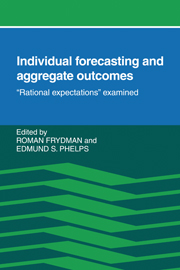Book contents
- Frontmatter
- Contents
- List of contributors
- Preface
- 1 Introduction
- 2 The trouble with “rational expectations” and the problem of inflation stabilization
- 3 Expectations of others' expectations and the transitional nonneutrality of fully believed systematic monetary policy
- 4 The stability of rational expectations in macroeconomic models
- 5 Individual rationality, decentralization, and the rational expectations hypothesis
- 6 Convergence to rational expectations equilibrium
- 7 A distinction between the unconditional expectational equilibrium and the rational expectations equilibrium
- 8 On mistaken beliefs and resultant equilibria
- 9 Equilibrium theory with learning and disparate expectations: some issues and methods
- 10 Keynesianism, monetarism, and rational expectations: some reflections and conjectures
- Index
10 - Keynesianism, monetarism, and rational expectations: some reflections and conjectures
Published online by Cambridge University Press: 05 June 2012
- Frontmatter
- Contents
- List of contributors
- Preface
- 1 Introduction
- 2 The trouble with “rational expectations” and the problem of inflation stabilization
- 3 Expectations of others' expectations and the transitional nonneutrality of fully believed systematic monetary policy
- 4 The stability of rational expectations in macroeconomic models
- 5 Individual rationality, decentralization, and the rational expectations hypothesis
- 6 Convergence to rational expectations equilibrium
- 7 A distinction between the unconditional expectational equilibrium and the rational expectations equilibrium
- 8 On mistaken beliefs and resultant equilibria
- 9 Equilibrium theory with learning and disparate expectations: some issues and methods
- 10 Keynesianism, monetarism, and rational expectations: some reflections and conjectures
- Index
Summary
To what extent is Keynesianism discredited? Is there anything left? Did Monetarism score a total victory? Must Rational Expectations make New Classical economists of us all? Every teacher of macroeconomics has to wrestle with these questions – hoping against hope that some new cataclysm will not let some fantastic supply-side doctrine or whatever sweep the field before he has been able to sort through the rubble of what once he knew. I am going to sort some of my rubble. The object of the exercise is to make some guesses at how the seemingly still usable pieces might fit together.
My starting points are as follows. Keynesianism foundered on the Phillips curve or, more generally, on the failure to incorporate inflation rate expectations in the model. The inflation, which revealed this critical fault for all to see, was in considerable measure the product of “playing the Phillips curve” policies. But the stable Phillips trade-off was not an integral part of Keynesian theory. Its removal, therefore, should not be (rationally) expected to demolish the whole structure.
Monetarism made enormous headway in the economics profession and with the public when the misbehavior of the Phillips curve and the inflation premium in nominal interest, rates became obvious for all to see. And few observers could continue to doubt the strong link between nominal income and money stock as the Great American Inflation went on and on and on.
- Type
- Chapter
- Information
- Individual Forecasting and Aggregate Outcomes'Rational Expectations' Examined, pp. 203 - 230Publisher: Cambridge University PressPrint publication year: 1984
- 3
- Cited by

